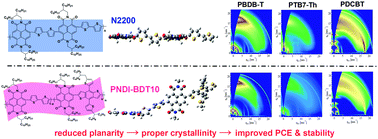Benzodithiophene-modified terpolymer acceptors with reduced molecular planarity and crystallinity: improved performance and stability for all-polymer solar cells†
Abstract
Polymer donor:polymer acceptor all-polymer solar cells (all-PSCs) demonstrate lower power conversion efficiency (PCE) than the state-of-art small-molecule acceptor organic solar cells (OSCs), because of the limited polymer acceptor species and relatively difficult control of film morphology. In this work, based on the most famous naphthalene diimide containing copolymer N2200, we report a series of A–D1–A–D2 type random terpolymer acceptors PNDI-BDTx (x = 5, 10 or 20), fabricated by replacing a certain amount of electron-donating bithiophene (T2) monomers with two-dimensional (2D) benzodithiophene (BDT) units. In combination with various polymer donors exhibiting varied optoelectronic and crystalline properties, improved photovoltaic performances were attained for the all-PSCs containing the terpolymer acceptors PNDI-BDT5 and PNDI-BDT10. The average PCEs of 5.80%, 3.90% and 1.96% obtained for the PNDI-BDT10 devices were consistently higher than 5.16%, 2.81% and 1.41% for devices containing the N2200 acceptor, when using PBDB-T, PTB7-Th and PDCBT as polymer donors, respectively. Compared with N2200, the random terpolymer PNDI-BDT10 exhibited less planarity and crystallinity, which induced favorable morphology with optimized phase separation, appropriately-sized domains and well-interpenetrated nanonetworks in polymer:polymer blends, and thus resulted in balanced charge transportation, higher exciton dissociation efficiency and suppressed charge recombination. Furthermore, in various PSCs based on the same PBDB-T donor, the terpolymer PNDI-BDT10 showed the best long-term device stability both at room-temperature and under 60 °C aging conditions for 240 h among all general types of electron acceptors such as copolymer N2200, small molecule ITIC and PC71BM.



 Please wait while we load your content...
Please wait while we load your content...